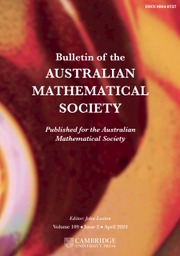Article contents
UNIQUE REPRESENTATION BI-BASIS FOR THE INTEGERS
Published online by Cambridge University Press: 12 September 2013
Abstract
For  $n\in \mathbb{Z} $ and
$n\in \mathbb{Z} $ and  $A\subseteq \mathbb{Z} $, let
$A\subseteq \mathbb{Z} $, let  ${r}_{A} (n)= \# \{ ({a}_{1} , {a}_{2} )\in {A}^{2} : n= {a}_{1} + {a}_{2} , {a}_{1} \leq {a}_{2} \} $ and
${r}_{A} (n)= \# \{ ({a}_{1} , {a}_{2} )\in {A}^{2} : n= {a}_{1} + {a}_{2} , {a}_{1} \leq {a}_{2} \} $ and  ${\delta }_{A} (n)= \# \{ ({a}_{1} , {a}_{2} )\in {A}^{2} : n= {a}_{1} - {a}_{2} \} $. We call
${\delta }_{A} (n)= \# \{ ({a}_{1} , {a}_{2} )\in {A}^{2} : n= {a}_{1} - {a}_{2} \} $. We call  $A$ a unique representation bi-basis if
$A$ a unique representation bi-basis if  ${r}_{A} (n)= 1$ for all
${r}_{A} (n)= 1$ for all  $n\in \mathbb{Z} $ and
$n\in \mathbb{Z} $ and  ${\delta }_{A} (n)= 1$ for all
${\delta }_{A} (n)= 1$ for all  $n\in \mathbb{Z} \setminus \{ 0\} $. In this paper, we construct a unique representation bi-basis of
$n\in \mathbb{Z} \setminus \{ 0\} $. In this paper, we construct a unique representation bi-basis of  $ \mathbb{Z} $ whose growth is logarithmic.
$ \mathbb{Z} $ whose growth is logarithmic.
Keywords
MSC classification
- Type
- Research Article
- Information
- Copyright
- Copyright ©2013 Australian Mathematical Publishing Association Inc.
References
- 4
- Cited by


